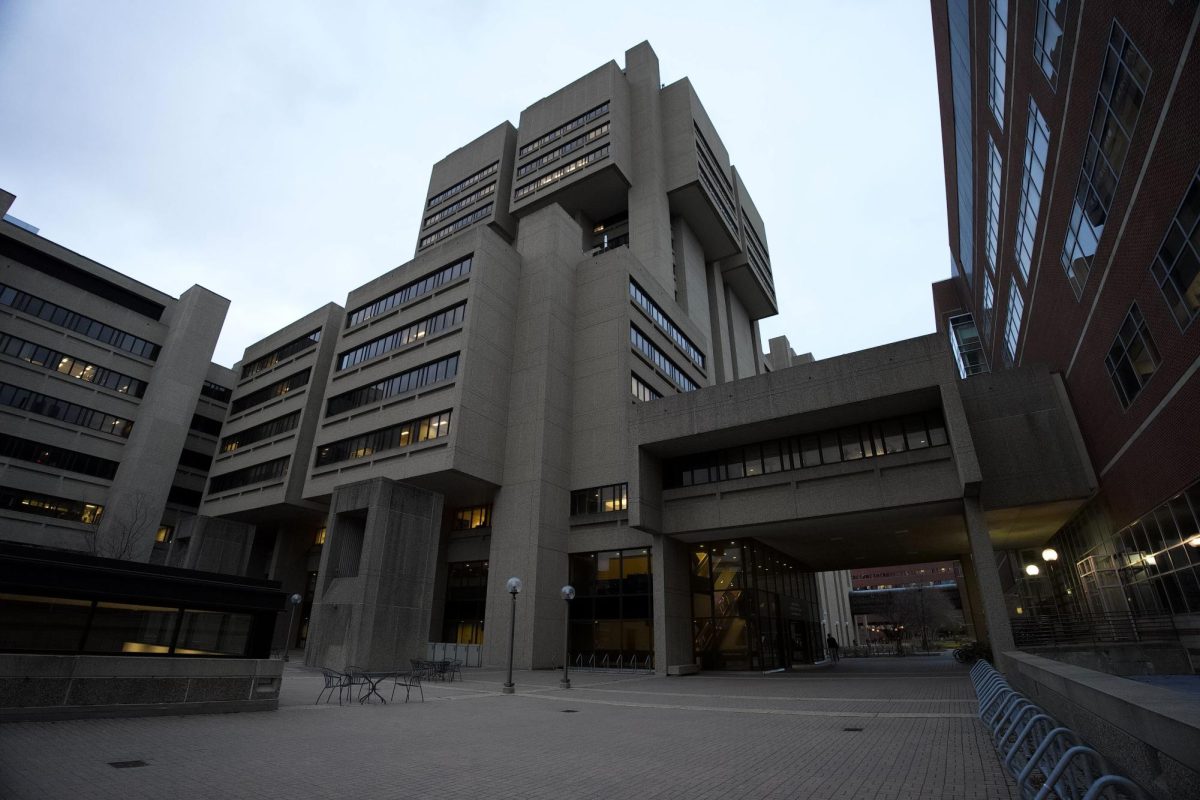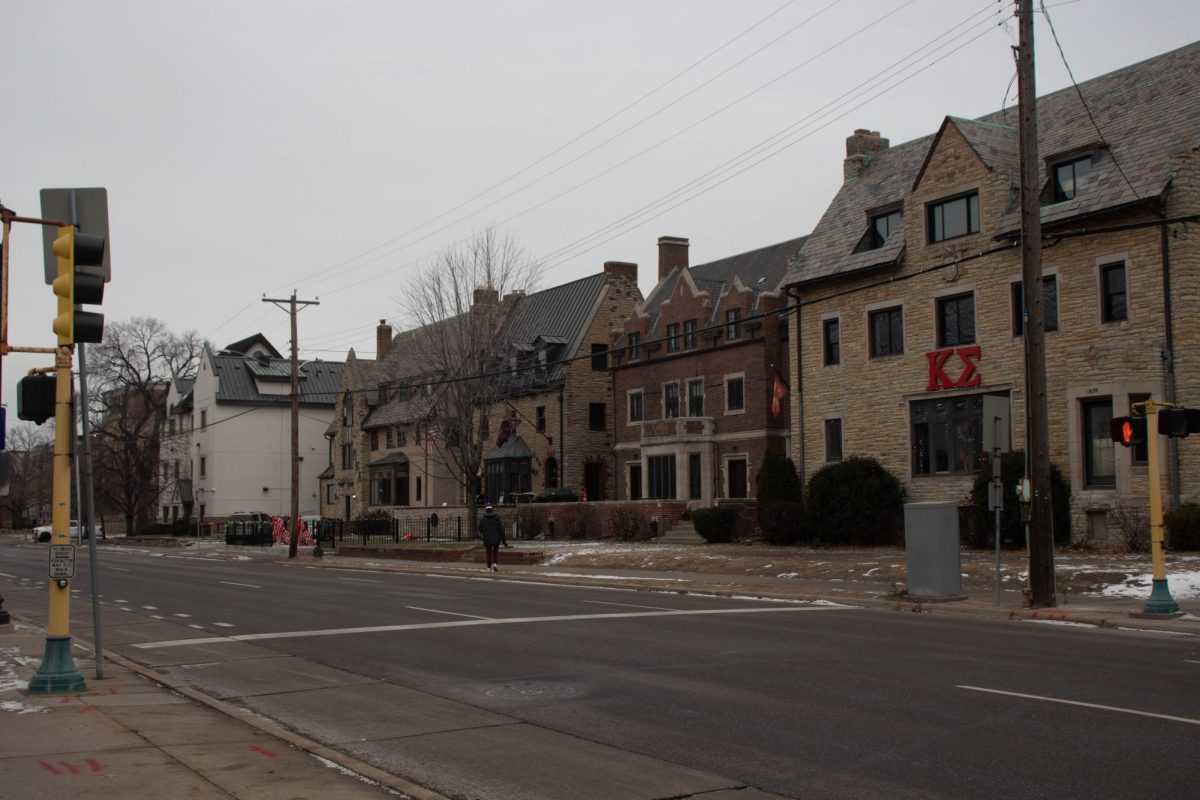From sidewalks to highways to entire buildings, concrete covers our city. It’s cold, uncomfortable to sit on and dull in color.
Still, concrete is beautiful.
My love for this cementitious building material centers around brutalist architecture, a type of building style that emerged in 1950s post-war Britain. Brutalist buildings are characterized by their use of raw materials — usually concrete — that adorn the facade. The design is often blocky and angular, giving structures an imposing presence.
Socialist nations in the 1960s and 1970s quickly jumped on the brutalism trend, using the unpretentious aesthetic of concrete to symbolize equality and a rejection of the bourgeois. Drawing on these socialist ideals, affordable housing projects in the U.S., like Riverside Plaza in the Cedar-Riverside neighborhood of Minneapolis, frequently used brutalist designs.
Kent Loiseaux-Purcell, a fourth-year architecture student and vice president of the American Institute of Architecture Students at the University of Minnesota, said brutalism has an important place in the history of architecture.
“I think it’s a really important movement that I feel like a lot of people don’t take the time to appreciate,” Loiseaux-Purcell said. “There’s just a lot of interesting buildings that were built in that movement, like the Barbican in London.”
Today, brutalism is out of style. Many buildings face condemnation or have deteriorated as a result of our country’s failure to properly upkeep them.
They’re scorned as ugly, soulless and oppressive. At the University, I often hear people describe concrete icons like Moos Tower, Rarig Center and Williamson Hall with utter contempt.
“It’s a very authoritative, powerful way of expressing architecture,” Loiseaux-Purcell said.
What if the harshness of brutalism was what gave it value?
Nick Moore, a third-year civil engineering student, appreciates brutalist architecture for the way it contrasts with other architectural styles on campus.“Having something that’s so starkly different from a lot of other different building types drives a lot of interest for me,” Moore said.
Considering the neoclassical Folwell Hall, the deconstructionist Weisman Art Museum and the art deco leanings of Comstock Hall, our university is like a botanical garden of architecture. The wide variety of building styles makes our campus memorable.
Brutalism is a specimen worth preserving for upholding that uniqueness.
Sure, Moos Tower may not take first prize in the beauty pageant, but looking up at seventeen stories of solid concrete is striking. The building looks like a giant fortress for a supervillain, but also sort of like teeth — it houses the School of Dentistry, after all.
There’s no forgetting Williamson Hall unless you happen to walk right over it. This subterranean building located in front of Folwell Hall houses the admissions office and some of the most unique architectural features on campus due to its submerged, angular windows that fill the underground space with sunlight. Like Moos Tower, it’s not necessarily inviting, but it is eye-catching, engaging and thought-provoking.
“Once these concrete buildings are here, that concrete will last centuries,” Moore said. “With just a little bit of upkeep, it’s going to last a really long time.”
Concrete is the most carbon-intensive construction material on the market today, but its ability to be easily formed and shaped has led to its prevalence in urban environments despite the environmental cost.
While I’m not advocating for a new wave of brutalist architecture, I think existing structures deserve respect.
What’s better? Apartment complexes that look like flimsy shipping containers?
Instead of putting profit over quality, brutalism puts functionality over aesthetics — a far better compromise than the jarring colors and corrugated metal that adorn more recent construction around campus.
At least the conventional ugliness of brutalism is intentional. New buildings like Identity Dinkytown and The Standard at Dinkytown have no excuse for disgracing the campus area.
Brutalist architecture does more than just defy architectural norms. Its design has genuine aesthetic value.
Consider the Rarig Center, a West Bank building that holds classrooms for the performing arts.
I remember looking up at Rarig on many walks back to my room during my first year at the University, thinking it looked sort of like a spaceship. Compared to my dorm — the boring and awkwardly designed Middlebrook Hall — it was memorable to live next to a building that felt uniquely tied to a cultural movement.
Brutalism questions what architecture can and should be. To dismiss it as ugly is naive. Not all art is pretty, nor should it be.
So criticize all you want, but that won’t stop me from looking up at the concrete facade of Moos Tower against a blue sky, drenched in golden sunlight and feeling inspired.















Mark
Dec 2, 2024 at 9:10 pm
Thankfully the Science Classroom Building that previously sat where Bruinicks Hall now sits was removed from campus. Moos Tower will probably be looked upon 2000 years from now like the pyramids are in Egypt, the mystery being not how, but why?
No name
Nov 27, 2024 at 11:55 am
“Brutalism puts functionality over aesthetics” – is that the best you’ve got?
Brutalism’s basic message is that people are incidental to the structures: You don’t deserve nice things, puny humans.
I’m not saying we should tear down Moos. But let’s not pretend they represent anything other than a terrible phase in western architecture. It is a shame that most universities were in expansion mode at the same time that architects decided that humanity was a waste.
I much prefer the dinkytown apartments, which at least look like they are designed with humans in mind.
Zarchitect
Nov 25, 2024 at 10:29 am
It looks like a big tooth and I like that. Another great article Sir Huppke, this one is like pop rocks (not the blue ones).
Greg L.
Nov 23, 2024 at 4:41 pm
One man’s low-cost, government-sponsored, soulless, gray block is another man’s beauty. Remember, your oppression is actually freedom.
bingrod
Nov 22, 2024 at 4:38 pm
Hard agree. Brutalism isn’t trying to be something it’s not, which is respectable especially when compared to the fugly carbon-copied “luxury” apartment buildings that keep poppin’ up like zits and manage to somehow already look outdated. Brutalism has a stoic beauty of its own.